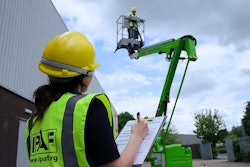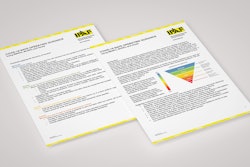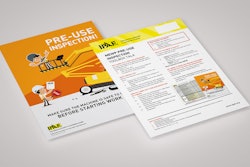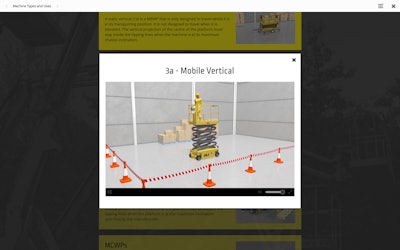
Every year, car enthusiasts impatiently wait for Detroit’s release of new models to see the latest designs and features available. For the mobile elevating work platform (MEWP) industry, the anticipation is particularly focused on the publication of new industry standards.
With existing standards last changed in 2006, the ANSI/SAIA A92 suite of A92.20 design, A92.22 safe use, and A92.24 training standards are introducing the most significant changes since the standard were first published in the 1970s.
The ANSI/SAIA A92.20 Design, Calculations, Safety Requirements, and Test Methods for Mobile Elevating Work Platforms (MEWPs) standard went into effect June 1, and any MEWP manufactured on or after that date must be designed and manufactured to the requirements of the standard. While most users will never read the standard, they will see the impact in the new equipment being manufactured. One improvement that may not be visually obvious is the addition of a platform load-sensing system, but it will be obvious to an operator if they exceed the rated workload. A visual and audible alarm will sound, and normal control functions will be limited. So be aware of what you are placing in the platform!
An increase in the minimum height of guard rails will become obvious on certain models of scissor lifts. The added height would prevent some prior models from passing through a standard doorway. New designs will address this – one manufacturer is lowering the scissor stack into the chassis, while others are providing folding guard rails. There will no longer be chain gates allowed at the platform entrance to a scissor lift—only a solid rail gate and all work platform entrances must include a toe board. The gate shall either return automatically to the closed position or be interlocked to prevent operation of the MEWP until it is closed.
In addition to the existing required alarm for tilt sensor, MEWPs will be prevented from certain movements when reaching allowed limits of chassis inclination. Simply ignoring the alarm will not allow additional movement in the direction of exceeded allowable slope. New stability design testing and wind force requirements will result in some models of lifts being heavier and many rough terrain scissor and booms allowing only foam-filled tires. There will be more options for MEWPs that can operate indoors, meaning no exposure to the wind. Some manufacturers will offer models that the operator can select indoor or outdoor (exposed to winds up to 28 mph) operation. Outdoor selection will likely reduce the platform capacity from two persons to one and may also limit the allowable platform height (i.e. 30 ft. indoor vs 27 ft. outdoor).
While concerns that over-regulating could limit the design of new MEWPs, the introduction of a drivable boom at 210 ft. should be proof that the standards can allow both greater safety and more efficient machines.
Risk Assessment
The ANSI/SAIA A92.22 Safe Use standard specifies requirements for application, inspection, training, maintenance, repair, and safe operation of MEWPs. If your MEWP safety plan consists of (1) train an operator, (2) rent a machine, and (3) go to work, your plan is missing some important steps and details to ensure safe operations. A92.22 introduces the responsibility for all MEWP users to develop a MEWP specific safe use plan, which builds the foundation of all aspects of safe MEWP operations while addressing the responsibilities for all involved from the user/employer to a MEWP platform occupant.
A MEWP specific safe use plan must include:
- performing a site risk assessment to identify hazards, evaluate risk, develop control measures, and communicate with affected persons;
- selection, provision and use of a suitable MEWP and work equipment associated with it;
- access, preparation, and maintenance of the site, as required, to include an assessment that the support surface is adequate to support the weight of the MEWP;
- MEWP maintenance including inspection(s) and repairs as required by this standard and by the manufacturer;
- only trained and authorized personnel are allowed to operate and/or occupy the MEWP;
- familiarization of authorized MEWP operator(s) with the specific MEWP to be used;
- inform the operator of local site requirements, and warn and provide the means to protect against identified hazards in the areas where the MEWP will be operated;
- have trained and qualified supervisor(s) to monitor the performance of the work of the operator to ensure compliance with provisions of this standard;
- prevention of unauthorized use of the MEWP;
- safety of persons not involved in the operation of the MEWP; and
- required documentation.
The safe use plan starts with a qualified person performing a site risk assessments that includes a MEWP rescue plan, and must additionally include proper MEWP and work equipment selection; proper access, preparation, and maintenance of the site for MEWP operations; maintenance and inspections, proper training, and qualification for MEWP operators; having trained and qualified supervisor(s) to monitor the performance of the work of the operator to ensure compliance with provisions of this standard; and consideration of safety of persons not involved in MEWP operations.
Starting with the risk assessment, the plan must include all of the required stages:
- Identify the task to be undertaken
- Select an appropriate MEWP
- Assess the risk associated with the task
- Identify control measures
- Identify safe work procedures
- Develop a site rescue plan
- Communicate the results.
All of these steps should have been employed with prior standards through the requirement for users to “warn personnel of potential hazards, provide means to protect against identified hazards.” The safe use standard defines it clearly.
Within the risk assessment is the requirement for a rescue plan – how to ensure a safe and timely rescue for a worker at height. Calling 9-1-1 is NOT a rescue plan, especially with MEWPs. The standard outlines consideration required for self-rescue, assisted rescue, and professional rescue. Consider that a worker stuck 180 ft. in the air may not be a task even 9-1-1 responders are equipped to address in a timely manner!
Trained Supervisors
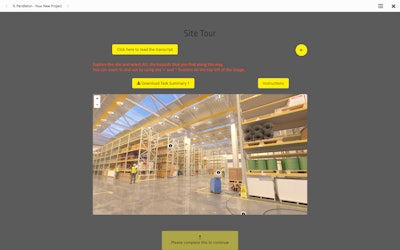 IPAF
IPAF
The user/employer must address: Who performs risk assessment? Who selects the MEWP for the task? Who will identify safe work procedures? Who will ensure the correct PPE is available for the task? Who will ensure the safe use plan is in place and is followed? ANSWER: It is the employer’s responsibility and the employer must authorize a qualified person, such as the MEWP supervisor, to assist with their MEWP safe use plan and compliance. The MEWP supervisor is the foundation of the plan.
The user/employer must have trained and qualified supervisor(s) to monitor the performance of the work of the operator to ensure compliance with the safe use plan. As part of the plan, supervisor training must include proper MEWP selection, the rules, regulations, and standards that apply to MEWPs, potential hazards associated with use of MEWPs and the means to protect against, and the importance of the MEWP manufacturer’s operation manuals.
The supervisor is the authorized person to ensure safe MEWP operations are in place, are communicated to all affected parties, and complied with. Having a trained operator is part of the plan, but a trained operator must also have model specific familiarization and be assessed if personnel are qualified to perform the task. The supervisor is critical in implementing the MEWP safe use plan.
MEWP supervisor training is a required tool for a person to become a qualified MEWP supervisor. This training is 100% theory knowledge and can be delivered by either a qualified instructor in a classroom setting OR online with an eLearning interactive training course. Today, the concerns with exposure to COVID-19 make online theory training a preferred deliverable. Online training can be taken 24/7 where internet access is available, and it can be taken at the convenience and pace of the trainee. IPAF has developed this course that can be registered at any IPAF approved training center.
A MEWP supervisor is not required to also be a MEWP operator but can be. In fact, as the operator must be evaluated on a regular basis to ensure proficiency, a MEWP supervisor may benefit from this training and experience. Awareness and compliance with all safe use requirements is the user’s best approach at achieving a safe and productive workplace.
General MEWP operator training is required for the relevant MEWP categories prior to the operator using the machine. So, for example, where a scissor lift operator previously required training in compliance with ANSI A92.6, today, it is A92.22/A92.24 category 3a (mobile vertical MEWP). A supervisor must ensure that operators are trained for the category MEWP selected for the task, familiarized with the model selected, and qualified to perform the required task.
Since the user has authorized the MEWP supervisor on sites where they have direct control over the application and operation of MEWPs, conforming with safety practices are his responsibility. Communicating the safety plan work procedures from the risk assessment is a starting point. Daily and ongoing monitoring of the performance of the operator to ensure compliance with the plan is another primary responsibility.
While the safety of the worker is obvious, the supervisor must additionally put in place precautions for the safety of persons not involved in the operation of the MEWP. Other workers on site or those just passing by, to include the general public, must be protected from workplace activities.
Training is Key
Included in workplace safety is ensuring MEWP occupants other than the MEWP operator have received the knowledge necessary to work safely from the work platform. As part of the rescue plan, a MEWP occupant needs to have the knowledge to operate the controls in an emergency where the operator cannot. This instruction does not give the occupant authorization to operate the controls at any time except in an emergency.
All of the required training for MEWP operators and supervisors, and the delivery of MEWP occupant knowledge, is addressed in the ANSI/SAIA A92.24 Training standard. Training is not a new requirement, but the methods and guidelines to prepare MEWP training materials, defining administrative criteria, and delivering elements required for proper training and familiarization are new.
The perception that operator training could occur when a rental MEWP is delivered is wrong. While machine familiarization can occur at the point of delivery, operator training requires much more planning. Having qualified trainers, required content for both theory and hands-on practical training, adherence to guidelines for the environment where both theory and practical training occur, testing, and documentation are requirements that operator training must address.
Effective training is a crucial component in becoming qualified for the task. It is the foundation for awareness of potential hazards and the need to develop methods to protect workers from the risk of harm from those hazards. A MEWP operator is not only trained on how to make a MEWP move safely, but the training also addresses other key performances such as daily machine visual and function test inspections, daily workplace inspections, routine maintenance (checking tire air pressure, fueling/charging batteries, checking fluid levels, etc.), and delivering occupant knowledge.
MEWP supervisor training provides the knowledge and understanding of all aspects of MEWP safe use, the development of a safe use plan and the awareness of known potential hazards, and how to mitigate their risk. The supervisor will become qualified to assess MEWP operators, monitor, and supervise their activities and evaluate them for proficiency.
MEWP users and their supervisors must read and understand the ANSI standards for safe use and training. Their responsibilities are offered in a manual that must be stored on the MEWP. A copy of a manual of responsibilities can be purchased for $1.50 from the A92 secretariat at shop.saiaonline.org/shopdisplayproducts.asp.
The ANSI A92 suite of design, safe use, and training standards became effective on June 1. MEWP operators and supervisors must be trained to these new safe use and training requirements to best ensure your workplace is safe and effective when using MEWPs.
Contact [email protected] for more information.
![Tony Groat Edited 5b57430ec070e[1] Headshot](https://img.forconstructionpros.com/files/base/acbm/fcp/image/2024/06/Tony_Groat_edited.5b57430ec070e_1_.667c30792412c.png?auto=format%2Ccompress&crop=faces&fit=crop&h=48&q=70&w=48)




